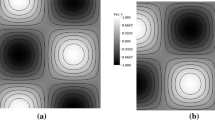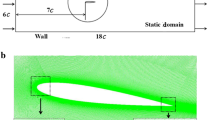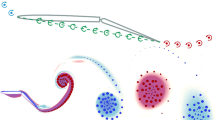Abstract
This paper presents the purely fast Lagrangian vortex method (FLVM) for the simulation of the external incompressible flows past heaving and pitching bodies with high-frequency oscillation. The Nascent vortex element is introduced to the flow field to retain the Lagrangian characteristics of the solver. The viscous effect is modeled using a core spreading method coupled with the splitting and merging spatial adaptation scheme. The particle’s velocity is calculated using Biot–Savart formulation. To accelerate computation, a fast multipole method (FMM) is employed. The validity of FLVM solver is verified by temporal and spatial convergence studies for the case of flows past an impulsively started cylinder at the Reynolds numbers ranging from 50 to 9500. The accuracy of FLVM is then confirmed for the simulation of flows around the pitching flat plate and oscillating airfoil. The time history of drag and lift coefficients and the vorticity contours show a good agreement with those reported in literature. Furthermore, the FLVM is employed to determine the flutter derivatives and flutter speed of an oscillating flat plate. Results are compared with theoretical solutions based on Theodorsen’s function. In general, the results agree well with those obtained by the inviscid theory.




















Similar content being viewed by others
References
Scanlan, R.H., Tomo, J.: Airfoil and bridge deck flutter derivatives. J. Eng. Mech. Div. 97(6), 1717–1737 (1971)
Larsen, A.: Prediction of aeroelastic stability of suspension bridges during erection. J. Wind Eng. Ind. Aerodyn. 72, 265–274 (1997)
Gunawan, L., Hadyan, H., Muhammad, H.: Measurements of flutter derivatives of a bridge deck sectional model. J. KONES 20, 107–116 (2013)
Albano, L., William, P.R.: A doublet-lattice method for calculating lift distributions on oscillating surfaces in subsonic flows. AIAA J. 7(2), 279–285 (1969)
Edwards, J.W., Bennett, R.M., Whitlow, W., Jr., Seidel, D.A.: Time-marching transonic flutter solutions including angle-of-attack effects. J. Aircr. 20(11), 899–906 (1983)
Alonso, J., Antony J., Fully-implicit time-marching aeroelastic solutions. In: 32nd Aerospace Sciences Meeting and Exhibit (1994)
Prananta, B.B., Hounjet, M.H.L., Zwaan, R.J.: Two-dimensional transonic aeroelastic analysis using thin-layer Navier-Stokes method. J. Fluids Struct. 12(6), 655–676 (1998)
Hall, K.C., Thomas, J.P., Dowell, E.H.: Proper orthogonal decomposition technique for transonic unsteady aerodynamic flows. AIAA J. 38(10), 1853–1862 (2000)
Bohbot, J., Julien G., Stephane T., Denis D.: Computation of the flutter boundary of an airfoil with a parallel Navier-Stokes solver. In: 39th Aerospace Sciences Meeting and Exhibit, p. 572 (2001)
Tang, D., Dowell, E.H.: Experimental and theoretical study on aeroelastic response of high-aspect-ratio wings. AIAA J. 39(8), 1430–1441 (2012)
Liu, F., Cai, J., Zhu, Y., Tsai, H.M., Wong, A.S.F.: Calculation of wing flutter by a coupled fluid-structure method. J. Aircr. 38(2), 334–342 (2001)
Chen, X., Zha, G., Hu, Z., Yang, M.T.: Flutter prediction based on fully coupled fluid-structural interactions. In: 9th National Turbine Engine High Cycle Fatigue Conference (2004)
Badcock, K.J., Woodgate, M.A., Richards, B.E.: Direct aeroelastic bifurcation analysis of a symmetric wing based on the Euler equations. J. Aircr. 42(3), 731–737 (2005)
Badcock, K.J., Woodgate, M.A.: Bifurcation prediction of large-order aeroelastic models. AIAA J. 48(6), 1037–1046 (2010)
Badcock, K.J., Timme, S., Marques, S., Khodaparast, H., Prandina, M., Mottershead, J.E., Woodgate, M.A.: Transonic aeroelastic simulation for instability searches and uncertainty analysis. Prog. Aerosp. Sci. 47(5), 392–423 (2011)
Timme, S., Marques, S., Badcock, K.J.: Transonic aeroelastic stability analysis using a Kriging-based Schur complement formulation. AIAA J. 49(6), 1202–1213 (2011)
Wang, K. G., Beran, P. S., Cao, S.: Adjoint-based mesh adaptation for direct flutter prediction. In: International Forum on Aeroelasticity and Structural Dynamics (2017)
Frandsen, J., McRobie, F.A.: Finite element simulation of wind-induced bridge motion. In: Proceedings of the International Symposium on Computational Methods for Fluid-Structure Interaction, Cambridge (1999)
Schulz, K.W., Kallinderis, Y.: Unsteady flow structure interaction for incompressible flows using deformable hybrid grids. J. Comput. Phys. 143, 569–597 (1998)
Larsen, A., Walther, J.H.: A two dimensional discrete vortex method for bridge aerodynamics applications. J. Wind Eng. Ind. Aerodyn. 67, 183–193 (1997)
Morgenthal, G.: Aerodynamic analysis of structures using high-resolution vortex particle methods. Dissertation, University of Cambridge, Cambridge, United Kingdom (2002)
Koumoutsakos, P., Leonard, A.: High-resolution simulations of the flow around an impulsively started cylinder using vortex methods. J. Fluid Mech. 296, 1–38 (1995)
Ploumhans, P., Winckelmans, G.S.: Vortex methods for high-resolution simulations of viscous flow past bluff bodies of general geometry. J. Comput. Phys. 165(2), 354–406 (2000)
Ploumhans, P., Winckelmans, G.S., Salmon, J.K., Leonard, A., Warren, M.S.: Vortex methods for direct numerical simulation of three-dimensional bluff body flows: application to the sphere at Re= 300, 500, and 1000. J. Comput. Phys. 178(2), 427–463 (2002)
Kamemoto, K.: On contribution of advanced vortex element methods toward virtual reality of unsteady vortical flows in the new generation of CFD. J. Braz. Soc. Mech. Sci. Eng. 26(4), 368–378 (2004)
Cottet, G.-H., Poncet, P.: Advances in direct numerical simulations of 3D wall-bounded flows by vortex-in-cell methods. J. Comput. Phys. 193(1), 136–158 (2004)
Yokota, R., Sheel, T.K., Obi, S.: Calculation of isotropic turbulence using a pure Lagrangian vortex method. J. Comput. Phys. 226(2), 1589–1606 (2007)
Morgenthal, G., Walther, J.H.: An immersed interface method for the vortex-in-cell algorithm. Comput. Struct. 85(11–14), 712–726 (2007)
Huang, M.J., Su, H.X., Chen, L.C.: A fast resurrected core-spreading vortex method with no-slip boundary conditions. J. Comput. Phys. 228(6), 1916–1931 (2009)
Huang, C.J., Huang, M.J.: A vortex method suitable for long time simulations of flow over body of arbitrary geometry. Comput. Fluids 74, 1–12 (2013)
Hammer, P., Altman, A., Eastep, F.: Validation of a discrete vortex method for low Reynolds number unsteady flows. AIAA J. 52(3), 643–649 (2014)
Mimeau, C., Cottet, G.H., Mortazavi, I.: Direct numerical simulations of three-dimensional flows past obstacles with a vortex penalization method. Comput. Fluids 136, 331–347 (2016)
Dung, D.V., Zuhal, L.R., Muhammad, H.: Two-dimensional fast Lagrangian vortex method for simulating flows around a moving boundary. J. Mech. Eng. 12, 31–46 (2015)
Zuhal, L.R., Febrianto, E.V., Dung, D.V.: Flutter speed determination of two degree of freedom model using discrete vortex method. Appl. Mech. Mater. 660, 639–643 (2014)
Greengard, L., Rokhlin, V.: A fast algorithm for particle simulations. J. Comput. Phys. 73, 325–348 (1978)
Hrycak, T., Rokhlin, V.: An improved fast multipole algorithm for potential fields. SIAM J. Sci. Stat. Comput. 19, 1804–1826 (1998)
Buard, R., Coutanceau, M.: The early stage of development of the wake behind an impulsively started cylinder for 40 < Re < 104. J. Fluid Mech. 101, 583–607 (1980)
Greengard, C.: The core-spreading vortex method approximations the wrong equation. J. Comput. Phys. 61, 345–348 (1985)
Rossi, L.: Resurrecting core-spreading vortex methods: a new scheme that is both deterministic and convergent. SIAM J. Sci. Comput. 17, 370–397 (1996)
Koumoutsakos, P., Leonard, A., Pepin, F.: Boundary conditions for viscous vortex methods. J. Comput. Phys. 113, 52–61 (1994)
Nagao, F., Utsunomiya, H., Murata, S.: Improvement of pitching moment estimation of an oscillating body by discrete vortex method. J. Wind Eng. Ind. Aerodyn. 67, 337–347 (1997)
Theodorsen, T., Mutchler, W.H.: General theory of aerodynamic instability and the mechanism of flutter. NACA Technical Report 496, United States (1935)
Walther, H.J., Larsen, A.: Two dimensional discrete vortex method for application to bluff body aerodynamics. J. Wind Eng. Ind. Aerodyn. 67, 183–193 (1997)
Kim, Y.C.: Vortex-in-cell method combined with a boundary element method for incompressible viscous flow analysis. Int. J. Numer. Methods Fluids 69, 1567–1583 (2011)
Taneda, S.: Studies on Wake Vortices (III). Experimental investigation of the wake behind a sphere at low Reynolds number. Rep. Res. Inst. Appl. Mech. 4, 99–105 (1956)
Zhang, H.Q., Fey, U., Noack, B.R., König, M., Eckelmann, H.: On the transition of the cylinder wake. Phys. Fluids 7(4), 779–794 (1995)
Barkley, D., Henderson, R.D.: Three-dimensional floquet stability analysis of the wake of a circular cylinder. J. Fluid Mech. 322, 215–241 (1996)
Williamson, C.H.K.: The natural and forced formation of spot-like vortex dislocations in the transition of a wake. J. Fluid Mech. 243, 393–441 (1992)
Thompson, M., Hourigan, K., Sheridan, J.: Three-dimensional instabilities in the wake of a circular cylinder. Exp. Thermal Fluid Sci. 12(2), 190–196 (1996)
Rasmussen, J.T., Cottet, G.H., Walther, J.H.: A multiresolution remeshed vortex-in-cell algorithm using patches. J. Comput. Phys. 230, 6742–6755 (2011)
Eldredge, J.D.: Numerical simulation of the fluid dynamics of 2D rigid body motion with the vortex particle method. J. Comput. Phys. 221(2), 626–648 (2007)
Kinsey, T., Dumas, G.: Parametric study of an oscillating airfoil in a power-extraction regime. AIAA J. 46(6), 1318–1330 (2008)
Ramesh, K., Gopalarathnam, A., Granlund, K., Ol, M., Edwards, J.: Discrete-vortex method with novel shedding criterion for unsteady aerofoil flows with intermittent leading-edge vortex shedding. J. Fluid Mech. 751, 500 (2014)
Yu, M., Wang, Z.J., Hu, H.: High fidelity numerical simulation of airfoil thickness and kinematics effects on flapping airfoil propulsion. J. Fluids Struct. 42, 166–186 (2013)
Author information
Authors and Affiliations
Corresponding author
Additional information
Publisher's Note
Springer Nature remains neutral with regard to jurisdictional claims in published maps and institutional affiliations.
Rights and permissions
About this article
Cite this article
Duong, V.D., Zuhal, L.R. & Muhammad, H. Fluid–structure coupling in time domain for dynamic stall using purely Lagrangian vortex method. CEAS Aeronaut J 12, 381–399 (2021). https://doi.org/10.1007/s13272-021-00511-z
Received:
Revised:
Accepted:
Published:
Issue Date:
DOI: https://doi.org/10.1007/s13272-021-00511-z




